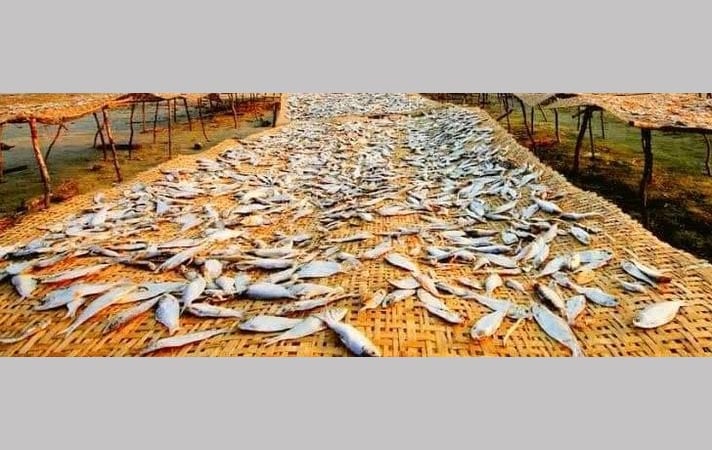News Flash
News Flash

CHATTOGRAM, Jan 18, 2025 (BSS)- Dry fish widely known as ‘Shutki’ has been gaining popularity among the foodies at home and abroad ushering a high hope of export prospect though its price becomes dearer over the year that may shrinks it’s markets.
From necessity to culinary habit, this variety of specially processed sea-fish in coastal belts is valued for its style of preservation, flavors and cultural tradition. Dry fish is a common daily meal menu of people of greater Chattogram, CHT and Cox’s Bazar region for a long time. They also like to entertain their guests because of its exceptionality in taste and smell.
As dry fish helps improve individual’s dietary diversity, food lovers often choice it for good taste, high nutritional value, unique aroma and distinctive flavor. Dieticians often prefer dry fishes free from insecticides and pesticides. They also suggest dry fish to reduce the risk of heart diseases, diabetes and obesity.
Both wholesale and retail traders as well as exporters anticipate that as an unconventional food and export items, dry fish of various popular varieties might have a bigger market abroad if there is proper financial and technical support from the government to produce more hygienic and health-hazard free organic dry fishes.
Vast coastal belts of Karnaphuli River and Bay of Bengal stretches from Khulna , Bhola , Chattogram to Cox’s Bazar specially Char Lakkhya , Ishanagar, Dangar Char, Fishery Ghat , Chaktai , Rajakhali , Anowara , Banshkhali , Kutubdia , Moheshkhali, Sonadia , St. Martin , Charfashion , Dublar Char become vibrant from the beginning of winter to monsoon as the fishermen and their hired workers remain busy with processing dried fish to meet growing domestic and foreign demands.
At least 20 to 25 species of fishes like small shrimp, Lattiya , Rupchanda , Churi, Lakkha , Chapa , Phopa are being processed at more than 200 spots locally known as ‘Shutki Machang’ in Chattogram and coastal upzillas of Banskhali and Anowara where 20000 to 25000 both male and female workers are engaged with this seasonal job.
Leaders of Asadganj Shutki depot, largest wholesale dried fish market in the country, told BSS that around 22,000 metric tons of dry fishes are produced locally per year which is less than half of year’s total demand for 54,750 metric tons. To meet up the demand huge quantities of dry fishes are imported from Myanmar, India and Pakistan.
Sources said around 70-80 percent of total dried fish exported from Bangladesh are supplied from Asadgonj and Chaktai wholesale markets.
About 47.6 lakh tons of various species of fishes were caught from sea and domestic sources in the fiscal 2021-2022, out of which 7 lakh tons of fishes were used for producing dried fish.
According to Export Promotion Bureau (EPB), Bangladesh fetched US$ 2.55 million in the first six months of 2023-2024 fiscal year by exporting dry fishes in different countries including Malaysia, UK, USA and Middle Eastern countries.
After meeting domestic demands, a good quantity of dried fish is exported to Middle East, Hong Kong, Thailand, Singapore, Europe and USA as demands for dry fishes of Chattogram belt is high in those countries.
Dry fishes from Chattogram are popular in those countries largely due to applying natural methods and using less health-hazard preservatives during processing the fishes after catching from sea, they said.
While visiting Bastuhara Colony area, adjacent to Karnaphuli River bank under Bakalia thana in the city, this correspondent have seen 120 Machangs (Bamboo made hanging makeshift facility for drying raw fish) located on 98 acres of land, around 5000 workers have been working in day and night shifts to prepare dry fishes.
Rasheda Khatun 35, a worker of a Machang said she gets Tk 300 per day. Like Rasheda, many other male and female workers, who were temporarily employed during dry fish processing season, are dependent on this livelihood.
Rabeya Khatun, a female labourer of another ‘machang’ said, each worker earns Tk 300 daily which they sue for their family.
Like Rasheda and Rabeya, around 2,000 women are running their families on the jobs at the shutki villages.
Noor Quader, a worker in Dangarchar, said, it takes 3 to 4 days to dry fish in sunny days. After that, the dried fish are packed and send to different parts of the country including wholesale markets.
Mohammad Ali, a wholesaler of Asadganj, said every season, 15 to 20 thousand metric tons of dry fishes including fish powder valuing about Tk. 50 crore are produced in these depots.
Besides meeting domestic demands, a good quantity of dry fishes is exported in the Middle East, Europe and America.
Alhaj Mohammad Ibrahim, former president of Asadganj Shutki Aratdar Samity, said that shutki was manufactured only in Bangladesh until 1980. It is now prepared in various coastal countries during the dry season.
President of Asadgonj Shutki Hoarders Association Md Nasir Uddin told BSS that even though the demand for dry fish is increasing in the country while the production is decreasing resulted in import from neighboring countries.
Abdus Satter, Assistant Director of Marine Fisheries Department here said the use of insecticides in dried fish processing is decreasing day by day as massive awareness and motivational campaign of public and private sectors stakeholders.